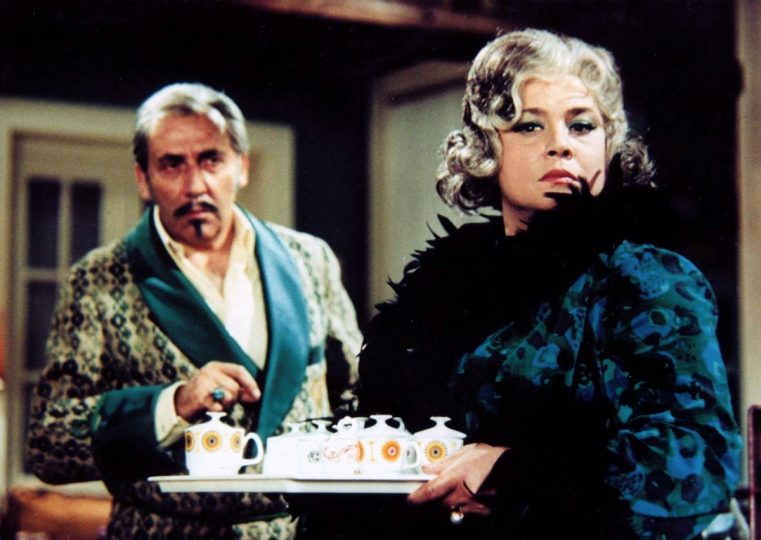Quite popular in Czechoslovakia during the 1970s were comedies adding supernatural motifs and fairy tale creatures against the grim reality of the ‘normalization’ period. One of the most successful of such works was Václav Vorlíček’s film released in cinemas in spring 1975. With more than 2.5 million viewers, the comedy How to Drown Dr. Mráček was the most visited film in the year of its release.
A recent screenwriting and dramaturgy graduate named Petr Markov co-wrote the screenplay with seasoned veteran Miloš Macourek. It occurred to Markov in his second year at the Film and TV School of the Academy of Performing Arts (FAMU) to include fairy tale creatures into our world. He assumed that water goblins and dwarves are immortal, and if they existed in ancient times, they must still be amongst us.
Markov wrote the synopsis entitled simply Water Goblins (Hastrmani) in February 1972. It was an anecdote about a water goblin’s daughter, named Jana, who falls in love with a mortal trying to deprive her of her home. Their love is so deep that, in the end, Jana turns from a water creature into a mere mortal. It was basically a variation on The Little Mermaid.
Markov elaborated on the premise in a short film story entitled Only the Best (Jen to nejlepší), adding another more important character: Jana’s overprotective father, standing in the way of his daughter’s happiness (on the pretext of only wanting the best for her). The author originally imagined a musical comedy with a pro-population growth message. One of the reasons Jana was to become a human was to conceive a child.
The short story was offered to Bořivoj Zeman or Jaroslav Balík. In the end, it was Václav Vorlíček who made the first version of the screenplay with Markov in November 1972. The basic plot elements remained the same, but the poetic musical comedy became a more ironic modern fairy tale.
Between 1972 and 1973, a new dramaturgic team was created in the Barrandov Film Studio led by the previous external dramaturgist Vladimír Kalina. His team took on Markov and Vorlíček’s water goblin screenplay. At the same time, the creative team was joined by Miloš Macourek.
As Macourek mentioned in several interviews, in the story, involving supernatural beings and humans, he had identified motifs they had already developed with Vorlíček in The Girl on the Broom (Dívka na koštěti, 1972). The second and third versions of the literary screenplay were thus made by Markov and Macourek.
With Macourek’s contribution, the central idea of the plot changed. The film was no longer promoting reproduction; it was meant to deepen the rejection of materialism and exploitation. These negative values are represented by the possessive Wasserman, the father of the main heroine, recklessly exploiting others for his own benefit.
The fourth and final version of the screenplay, elaborating on the motifs and motives of the previous ones, was made by Macourek only. The plot line of the final story revolves around the effort of a conscientious housing officer to move a family of Prague water goblins out of their damp dwelling on Prague’s Kampa Island and into a first-class apartment. But they don’t like the idea of living in a dry block of flats. Wasserman is plotting how to get rid of the inconvenient officer.
As Markov recalls, even though the literary basis was done in 1973, the shooting had to be postponed by a year due to an illness affecting all three main authors. When the screenplay was finally executed, Vorlíček offered an acting opportunity both to legends (such as Miloš Kopecký, František Filipovský or Vladimír Menšík) and young stars (such as Jaromír Hanzlík and Libuše Šafránková).
The unique atmosphere of the film is completed by costumes by Theodor Pištěk, original tricks by the cinematographer Vladimír Novotný, and music by Vítězslav Hádl, who also composed the opening song, A Maiden Knew a Man (Znala panna pána), sung by Helena Vondráčková and Václav Neckář.
In the end, the film was very different from the original synopsis. Nevertheless, Petr Markov came back to the original idea in his book The End of Water Goblins in Bohemia (Konec vodníků v Čechách) published in 1980. Even though the story differs from the film, the writer used several ideas and dialogues from the short stories and the various versions of the screenplay.
The film How to Drown Dr. Mráček is now coming back to cinemas in a new digitally restored version.
How to Drown Dr. Mráček (Jak utopit dr. Mráčka aneb Konec vodníků v Čechách, Czechoslovakia 1974), director: Václav Vorlíček, screenplay: Miloš Macourek, Petr Markov, Václav Vorlíček, director of photography: Vladimír Novotný, music: Vítězslav Hádl, cast: Libuše Šafránková, Jaromír Hanzlík, František Filipovský, Miloš Kopecký, Vladimír Menšík, Zdeněk Řehoř, Stella Zázvorková et al. Filmové studio Barrandov, 96 min.


